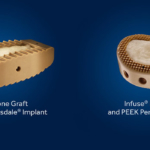Pivox™ Oblique Lateral Spinal System
July 15, 2016
Medtronic Launches Revamped Minimally Invasive Spine Fusion Procedures
Innovative Procedural Solutions Offer Efficiencies for Surgeons Using a Lateral Approach
 Medtronic plc recently announced the continued development of the OLIF Platform with the launch of the Pivox Oblique Lateral Spinal System with Lateral Plate for OLIF25 and Divergence-L Anterior/Oblique Lumbar Fusion System for OLIF51 at the International Meeting on Advanced Spine Techniques (IMAST) in Washington, D.C. Lumbar interbody fusions aim to stabilize the back by fusing two or more vertebrae with bone grafts or devices.
Medtronic plc recently announced the continued development of the OLIF Platform with the launch of the Pivox Oblique Lateral Spinal System with Lateral Plate for OLIF25 and Divergence-L Anterior/Oblique Lumbar Fusion System for OLIF51 at the International Meeting on Advanced Spine Techniques (IMAST) in Washington, D.C. Lumbar interbody fusions aim to stabilize the back by fusing two or more vertebrae with bone grafts or devices.
Oblique Lateral Interbody Fusion (OLIF) is a surgical technique that minimizes cutting to muscles and addresses unmet needs seen with traditional lateral approaches by utilizing an oblique-lateral trajectory to access multiple levels of the lumbar spine.
Compared to traditional approaches, the OLIF25 and OLIF51 Procedures:
- Use minimally invasive techniques that minimize muscle disruption,
- Allow for increased access to certain levels of the spine, and
- Employ direct visualization to ensure an approach to the disc space free from vascular, peritoneal, and nerve obstructions.
The OLIF25 Procedure helps surgeons preserve the patient's psoas muscle when treating the L2-L5 levels of the spine and gives surgeons easier access around the patient's iliac crest - enabling placement of an implant into the disc space for anterior column support. It also reduces patient positioning steps and allows for a more upright surgeon posture with direct visualization of the disc space, psoas muscle, and anterior longitudinal ligament.
The OLIF51 Procedure provides lateral access to the L5-S1 disc space and doesn't require surgeons to reposition the patient if multiple levels of surgery are conducted. The incision for the OLIF51 technique spares the abdominal muscles and allows gravity to aid in retraction. OLIF Procedures incorporate Medtronic's comprehensive surgical platform of access, interbody, navigation, fixation and biologic options.
"In my opinion, OLIF is one of the least invasive manners in which to achieve successful fusion in the lumbar spine. OLIF minimizes disruption of the tissues surrounding the spine, particularly the psoas muscle and the embedded nerves.
There is no need to use neuromonitoring, and the entire procedure can be done without repositioning the patient,"
said Kamal R. Woods, MD, FAANS, a neurosurgeon at Advanced Neurosurgery Associates in Murrieta, CA. "As with any anterolateral procedure, safe access to the spine is critical. The OLIF25 and OLIF51 retractor systems enhance the ease and reproducibility of the procedure."
The Pivox Oblique Lateral Spinal System with Lateral Plate is an innovative interbody cage and plate engineered for the OLIF25 procedure. It can be used together at one or two contiguous levels from L2 to S1 without the need for additional posterior fixation.
The Divergence-L Anterior/Oblique Lumbar Fusion System is the first plate/interbody all-in-one system for both the OLIF51 procedure and the ALIF procedure. The Divergence-L system has specifically designed plates for the oblique or anterior approach and has a large footprint with multiple height and lordosis options to provide desired disc height and segmental lordosis.
"Our goal is to enable the best possible patient care, so we continue to innovate and evolve spine surgery to address unmet needs," said Doug King, senior vice president and president of Medtronic's Spine division, which is part of the Restorative Therapies Group at Medtronic. "The OLIF Procedures represent an evolution in lateral access, and we're pleased to see more surgeons undertaking this evolution in their approach."
Risks associated with minimally invasive spine surgery include transitioning to a conventional open procedure, neurological damage, damage to the surrounding soft tissue, and, where used, instrument malfunction.
Other risks associated with implants used include device migration, nonfusion, loss of spinal curvature, correction, height, and/or reduction. Minimally invasive procedures may be associated with longer operative times.
In the United States, more than 250,000 individuals with a variety of spinal conditions, like degenerative disc disease or deformities, undergo spinal fusions annually to treat degenerative changes in the lumbar spine.
About Pivox Oblique Lateral Spinal System Cage
- Use with autograft and/or allogenic bone graft comprised of cancellous and/or corticocancellous bone graft to facilitate interbody fusion;
- In patients with Degenerative Disc Disease (DDD) at one or two contiguous levels from L2 to S1, with or without up to Grade 1 Spondylolisthesis or retrolisthesis at the involved levels; used with supplemental fixation cleared for use in the lumbar spine; and
- To provide anterior column support in patients with degenerative scoliosis as an adjunct to pedicle screw fixation.
Plate and Screws
- Supplemental fixation: Oblique or lateral L1-L5 above the vascular structures bifurcation; anterior L5-S1 below the bifurcation;
- Temporary stabilization in patients with DDD; trauma; tumors; deformity; pseudarthrosis; and/or failed previous fusions.
Cage with Plates and Screws
- In patients with DDD at one or two contiguous levels from L2 to S1, with or without up to Grade 1 Spondylolisthesis or retrolisthesis at the involved levels.
About Divergence-L Anterior/Oblique Lumbar Fusion System Plate and Bone Screws
- Supplemental fixation: Anterior oblique L1-L5 above the vascular bifurcation; anterior L5-S1 below the bifurcation;
- Temporary stabilization in patients with Degenerative Disc Disease (DDD); trauma; tumors; deformity; pseudarthrosis; and/or failed previous fusions.
Interbody Cage
- Interbody fusion in patients with DDD at one or two contiguous levels from L2 to S1, with or without up to a Grade 1 Spondylolisthesis or retrolisthesis at the involved levels.
- Required use with autogenous bone graft
- Intended use with supplemental fixation cleared for use in the lumbar spine. Cages with a lordosis of 18º or greater must be used with at least supplemental anterior fixation.
When used together, Divergence-L components can be used only in patients with Interbody Cage indications.
The Pivox Oblique Lateral Spinal System with Lateral Plate for OLIF25 and Divergence-L Anterior/Oblique Lumbar Fusion System for OLIF51 incorporate the technology of Gary K. Michelson, MD.

This product incorporates technology developed by Gary K. Michelson, M.D.


 Medtronic
Medtronic